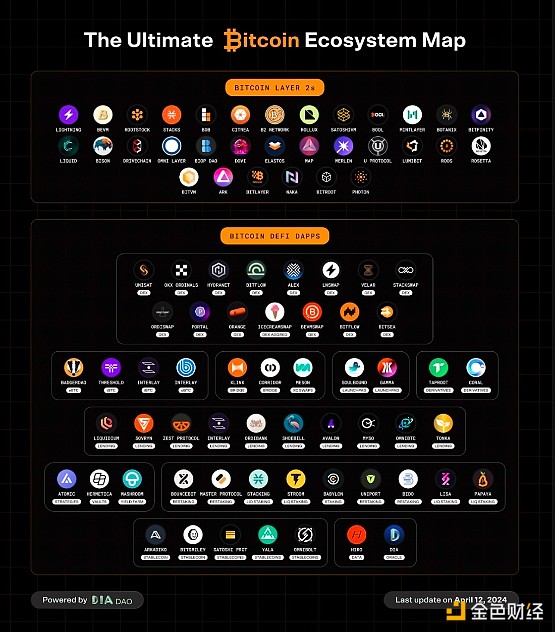Author: Alex O’Donnell, CoinTelegraph; Compiled by Wuzhu, Golden Finance
BTC has always been an excellent store of value, but the yield has been poor. Fortunately, the days of BTC yields below 0.5% are coming to an end. The opportunities emerging in Bitcoin’s Layer 2 (L2) and decentralized finance (DeFi) ecosystems are changing the rules of the game.Here’s how to prepare for the coming BTC yield boom.
Bitcoin mining used to be the only way to earn meaningful BTC rewards. Ordinary holders had to settle for unreliable centralized finance (CeFi) platforms (such as the now-defunct Celsius and Voyager) or pitiful DeFi yields. As of September 5, DeFi lending platform Aave was paying Wrapped Bitcoin (WBTC) depositors an annual interest rate of just 0.04%.
That’s changing. After years of quiet development, Bitcoin’s L2 scaling networks, such as the Lightning Network, Core Chain, Rootstock (RSK), and Stacks, are gaining traction. As of Sept. 5, the total value locked (TVL) in Bitcoin L2 has soared to about $1.4 billion, according to DeFiLlama. That’s up nearly 275% year to date and 10x since 2023.
L2 developer CoreDAO’s Brendon Sedo noted that he expects Bitcoin L2 to account for a large portion of Bitcoin’s $1 trillion-plus market cap in the coming years.
Bitcoin Native Staking
Some L2s, including Core Chain, Babylon, and Spiderchain, are exploring Bitcoin native staking. Similar to proof-of-stake (PoS) networks like Ethereum, Bitcoin L2 stakers lock up BTC as collateral to secure the network in exchange for rewards.
Meanwhile, Liquid Staking Derivatives (LSD) protocols are bringing BTC staking yields to more L2s. These protocols issue tokenized claims on staking pools and include Core Earn, Bedrock, Stroom, and Pell Network.

Bitcoin Layer 2 and the DeFi ecosystem as of April 12, 2024. Source: DIA DAO
It’s still early. Spiderchain is still in the testnet stage, and Babylon has not yet started issuing rewards. But CoreChain’s LSD, stBTC, is already live — and claims a reward rate of 8.8%.
That’s much higher than the PoS network Solana.
Crucially, Core Chain pays stakers fees in its native token, CORE, rather than BTC. Remember, always do your own research and carefully consider whether a crypto strategy is right for you before following suit — or you’ll lose money!
Bitcoin L2 isn’t just about staking. There’s RSK, Merlin, and Stacks — already hosting a Bitcoin-native DeFi ecosystem, including decentralized exchanges (ALEX, Bitflow), lending protocols (MoneyOnChain, Zest), and all-in-one platforms like Sovryn. Merlin even touts a Bitcoin-native derivatives protocol, Surf.
Payment protocol Lightning Network, launched in 2018, remains highly regarded today, with nearly $300 million in total locked value, according to DeFiLlama. Node operators — who provide BTC liquidity to Lightning payment channels in exchange for fees — earn an average annual interest rate of 5.62% in BTC, according to Magma, a lightning channel marketplace.
Similar to bitcoin mining, lightning nodes are dominated by professional shops such as LQWD Technologies Corp rather than retail holders.
Institutional Interest
These BTC staking protocols won’t remain ignored for long. Institutional staking services including Kiln and Figment already support staking Stacks’ native token STX, which pays rewards in BTC from network fees. They may add more networks soon.
In May, asset manager Valour launched the Valour Bitcoin Staking (BTC) SEK ETP, an exchange-traded product (ETP) listed on Scandinavian exchange Nordic Growth Market. It stakes BTC on Core Chain. Valour launched the Core Chain validator node in June.
On September 3, asset manager 21.co launched its regulated BTC wrapper, 21.co Wrapped Bitcoin (21BTC). More institutional liquidity is expected to follow.
Wrapped Bitcoin
The most compelling possibility for BTC in DeFi is on Ethereum. Launched in 2023, restaking protocol EigenLayer has been a game-changer for cryptocurrencies, and BTC is no exception.
EigenLayer supports a growing number of “active validation services” (AVSs) — protocols that use EigenLayer’s nearly $12 billion pool of restaking ETH to secure themselves. In November, AVSs will begin paying for the privilege from protocol revenues, creating a yield for restakers.
EigenDA, EigenLayer’s first and largest AVS, added native L2 token restaking in August. This effectively extends re-collateralization from ETH and EigenLayer’s native EIGEN token to nearly any virtual asset — including wrapped BTC.
In August, liquid re-collateralization protocol Swell launched swBTC to pay out yields on WBTC. EigenLayer is expected to add wrapped BTC re-collateralization soon.
Another interesting option is Synthetix, a DeFi derivatives platform that launched its next-generation V3 protocol on Arbitrum (ARB) in July. Unlike its competitors, Synthetix V3 is designed to accept nearly any token as collateral. Liquidity providers (LPs) earn trading fees, plus additional rewards in Synthetix’s native token SNX. As of September 5, wrapped ETH LPs are earning 7.6% on Arbitrum.
Only a few pools are currently active, and creating new pools requires approval from Synthetix governance advisors. However, WBTC pools are expected to appear on Synthetix v3 soon.
One thing is certain. Whether on the Ethereum scaling chain or Bitcoin L2, holding BTC is becoming more and more interesting. Stay vigilant, otherwise the opportunity may slip away from you.
 JinseFinance
JinseFinance








